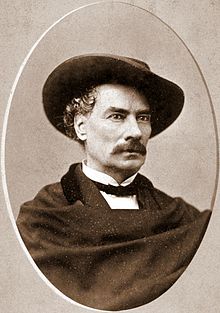| Revision as of 02:21, 16 August 2013 editNikkimaria (talk | contribs)Autopatrolled, Extended confirmed users232,657 editsm fixed dashes using a script← Previous edit | Revision as of 22:19, 25 August 2013 edit undoAboutmovies (talk | contribs)Autopatrolled, Extended confirmed users, IP block exemptions, Pending changes reviewers, Rollbackers412,518 edits removed Category:People from San Francisco, California; added Category:Writers from San Francisco, California using HotCatNext edit → | ||
| Line 50: | Line 50: | ||
| ] | ] | ||
| ] | ] | ||
| ] | ] | ||
| ] | ] | ||
| ] | ] | ||
Revision as of 22:19, 25 August 2013
| John Carey Cremony | |
|---|---|
 Cremony in 1873 Cremony in 1873 | |
| Born | 1815 Boston, Massachusetts |
| Died | August 24, 1879 San Francisco, California |
| Years of service | 1861–1872 |
| Rank | Major |
| Unit | 1st Regiment California Volunteer Cavalry |
| Commands | 1st Battalion of Native Cavalry, California Volunteers |
| Battles / wars | Mexican American War, American Civil War, Apache Wars |
| Other work | author |
Major John C. Cremony (1815 – August 24, 1879) was an American newspaperman who enrolled in the Massachusetts Volunteers in 1846, serving as a lieutenant.
He served as a Spanish language interpreter for the U.S. Boundary Commission which laid out the Mexican and United States Border between 1849–1852. He went on to serve as Captain in Company B, 2nd Regiment California Volunteer Cavalry a unit of California Volunteers, with the California Column in New Mexico Territory. He eventually achieved the rank of Major in 1864 and commanded the 1st Battalion of Native Cavalry, California Volunteers until 1866. He was the first editor of San Francisco's Weekly Sunday Times newspaper.
Cremony served most of his military career in the Southwest and personally knew Apache Chiefs Mangas Coloradas and Cochise. He was the first white man to become fluent in the Apache language, learning it in his role as an interpreter, and publishing the first written compilation of their language as a glossary for the army. As a result, Cremony was often able to resolve numerous issues between the military, reservation authorities and the Apaches. Not all of Cremony's discourses with the Apache were peaceful, however. He killed one warrior in a grueling knife fight and chronicled a non-stop 21-hour chase when he was pursued by a band of Sierra Blanca Apache (White Mountain Apache) of some 125 miles (201 km) through the desert of New Mexico while on horseback; 70 miles (110 km) of which were at a full gallop. Cremony authored Life Among the Apaches, published in 1869, which described his experiences with the tribe.
After retiring from the army, Cremony settled in San Francisco, becoming a founding member of the Bohemian Club and establishing the club's membership guidelines in 1872. He died of tuberculosis on August 24, 1879 and is buried at Cypress Lawn Memorial Park on the Laurel Hill Mound in San Francisco, California.
Bibliography
References
- Joseph Norman Heard (1987). Handbook of the American Frontier: The far west. Scarecrow Press. p. 82. ISBN 978-0-8108-3283-1.
- ^ Soldier in the California Column, The Diary of John W. Teal, Arizona and the West, Vol. 13, No. 1 (Spring, 1971), p. 33
- Soldier in the California Column, The Diary of John W. Teal, Arizona and the West, Vol. 13, No. 1 (Spring, 1971), pp. 33–82
- ^ Varner, K.(2007)John Cremony.Cypress Lawn Heritage Newsletter. 5(3)p.6
- Secrest, William B. (2006). California Badmen: Mean Men with Guns. Quill Driver Books. p. 25. ISBN 978-1-884995-51-4.
- ^ Nevin, David (1973). The Old West: The Soldiers. New York: Time Life. p. 238. ISBN 978-1-4161-2448-1.
{{cite book}}: Cite has empty unknown parameter:|coauthors=(help) - Geronimo (edited by Barrett) Geronimo, His Own Story New York: Ballantine Books 1971. ISBN 0-345-28036-9.